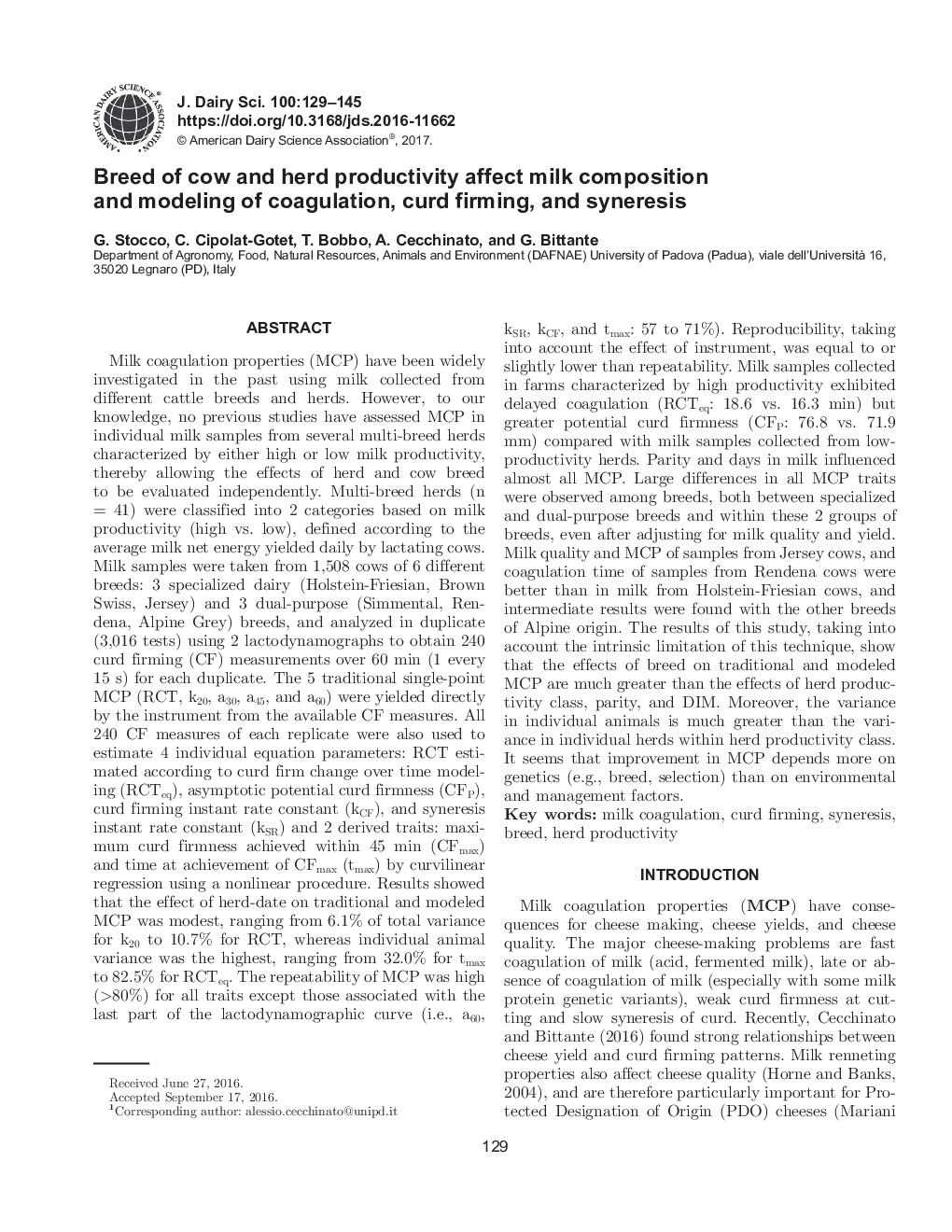| کد مقاله | کد نشریه | سال انتشار | مقاله انگلیسی | نسخه تمام متن |
|---|---|---|---|---|
| 5542558 | 1402520 | 2017 | 17 صفحه PDF | دانلود رایگان |
عنوان انگلیسی مقاله ISI
Breed of cow and herd productivity affect milk composition and modeling of coagulation, curd firming, and syneresis
ترجمه فارسی عنوان
نژاد بهره وری گاو و گله بر ترکیب شیر و مدل سازی انعقاد، سفت شدن قارچ و سینرزس تاثیر می گذارد
دانلود مقاله + سفارش ترجمه
دانلود مقاله ISI انگلیسی
رایگان برای ایرانیان
موضوعات مرتبط
علوم زیستی و بیوفناوری
علوم کشاورزی و بیولوژیک
علوم دامی و جانورشناسی
چکیده انگلیسی
Milk coagulation properties (MCP) have been widely investigated in the past using milk collected from different cattle breeds and herds. However, to our knowledge, no previous studies have assessed MCP in individual milk samples from several multi-breed herds characterized by either high or low milk productivity, thereby allowing the effects of herd and cow breed to be evaluated independently. Multi-breed herds (n = 41) were classified into 2 categories based on milk productivity (high vs. low), defined according to the average milk net energy yielded daily by lactating cows. Milk samples were taken from 1,508 cows of 6 different breeds: 3 specialized dairy (Holstein-Friesian, Brown Swiss, Jersey) and 3 dual-purpose (Simmental, Rendena, Alpine Grey) breeds, and analyzed in duplicate (3,016 tests) using 2 lactodynamographs to obtain 240 curd firming (CF) measurements over 60 min (1 every 15 s) for each duplicate. The 5 traditional single-point MCP (RCT, k20, a30, a45, and a60) were yielded directly by the instrument from the available CF measures. All 240 CF measures of each replicate were also used to estimate 4 individual equation parameters: RCT estimated according to curd firm change over time modeling (RCTeq), asymptotic potential curd firmness (CFP), curd firming instant rate constant (kCF), and syneresis instant rate constant (kSR) and 2 derived traits: maximum curd firmness achieved within 45 min (CFmax) and time at achievement of CFmax (tmax) by curvilinear regression using a nonlinear procedure. Results showed that the effect of herd-date on traditional and modeled MCP was modest, ranging from 6.1% of total variance for k20 to 10.7% for RCT, whereas individual animal variance was the highest, ranging from 32.0% for tmax to 82.5% for RCTeq. The repeatability of MCP was high (>80%) for all traits except those associated with the last part of the lactodynamographic curve (i.e., a60, kSR, kCF, and tmax: 57 to 71%). Reproducibility, taking into account the effect of instrument, was equal to or slightly lower than repeatability. Milk samples collected in farms characterized by high productivity exhibited delayed coagulation (RCTeq: 18.6 vs. 16.3 min) but greater potential curd firmness (CFP: 76.8 vs. 71.9 mm) compared with milk samples collected from low-productivity herds. Parity and days in milk influenced almost all MCP. Large differences in all MCP traits were observed among breeds, both between specialized and dual-purpose breeds and within these 2 groups of breeds, even after adjusting for milk quality and yield. Milk quality and MCP of samples from Jersey cows, and coagulation time of samples from Rendena cows were better than in milk from Holstein-Friesian cows, and intermediate results were found with the other breeds of Alpine origin. The results of this study, taking into account the intrinsic limitation of this technique, show that the effects of breed on traditional and modeled MCP are much greater than the effects of herd productivity class, parity, and DIM. Moreover, the variance in individual animals is much greater than the variance in individual herds within herd productivity class. It seems that improvement in MCP depends more on genetics (e.g., breed, selection) than on environmental and management factors.
ناشر
Database: Elsevier - ScienceDirect (ساینس دایرکت)
Journal: Journal of Dairy Science - Volume 100, Issue 1, January 2017, Pages 129-145
Journal: Journal of Dairy Science - Volume 100, Issue 1, January 2017, Pages 129-145
نویسندگان
G. Stocco, C. Cipolat-Gotet, T. Bobbo, A. Cecchinato, G. Bittante,
